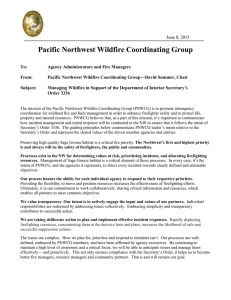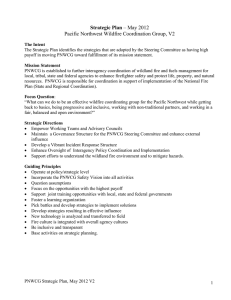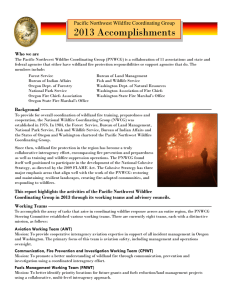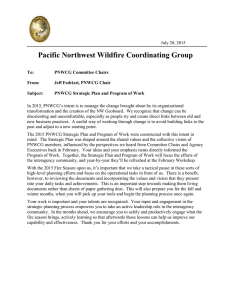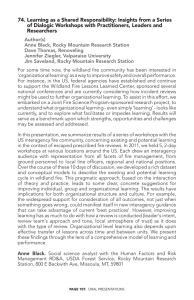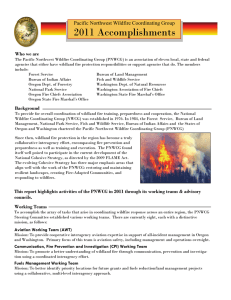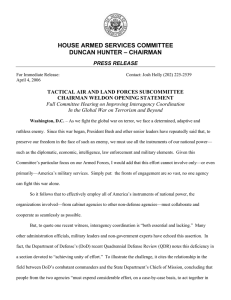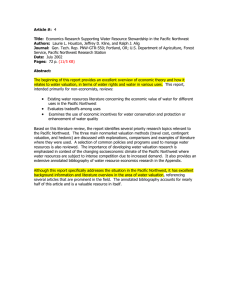2012 Accomplishments Pacific Northwest Wildfire Coordinating Group Who we are
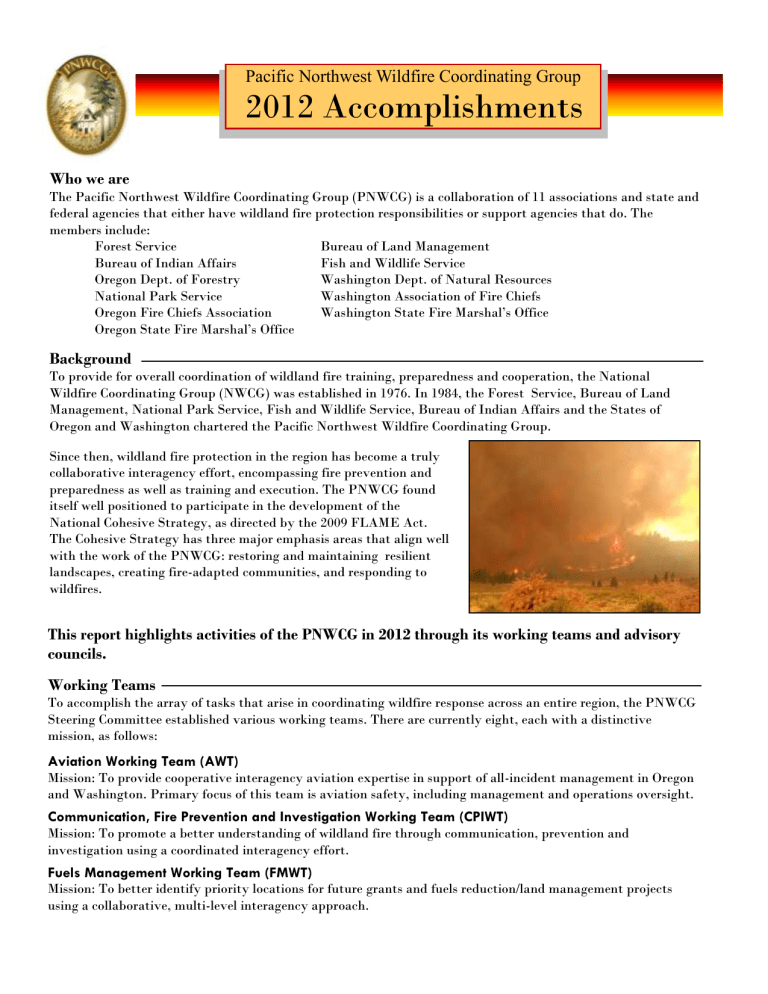
Pacific Northwest Wildfire Coordinating Group
2012 Accomplishments
Who we are
The Pacific Northwest Wildfire Coordinating Group (PNWCG) is a collaboration of 11 associations and state and federal agencies that either have wildland fire protection responsibilities or support agencies that do. The members include:
Forest Service
Bureau of Indian Affairs
Oregon Dept. of Forestry
Bureau of Land Management
Fish and Wildlife Service
Washington Dept. of Natural Resources
National Park Service
Oregon Fire Chiefs Association
Oregon State Fire Marshal’s Office
Washington Association of Fire Chiefs
Washington State Fire Marshal’s Office
Background
To provide for overall coordination of wildland fire training, preparedness and cooperation, the National
Wildfire Coordinating Group (NWCG) was established in 1976. In 1984, the Forest Service, Bureau of Land
Management, National Park Service, Fish and Wildlife Service, Bureau of Indian Affairs and the States of
Oregon and Washington chartered the Pacific Northwest Wildfire Coordinating Group.
Since then, wildland fire protection in the region has become a truly collaborative interagency effort, encompassing fire prevention and preparedness as well as training and execution. The PNWCG found itself well positioned to participate in the development of the
National Cohesive Strategy, as directed by the 2009 FLAME Act.
The Cohesive Strategy has three major emphasis areas that align well with the work of the PNWCG: restoring and maintaining resilient landscapes, creating fire-adapted communities, and responding to wildfires.
This report highlights activities of the PNWCG in 2012 through its working teams and advisory councils.
Working Teams
To accomplish the array of tasks that arise in coordinating wildfire response across an entire region, the PNWCG
Steering Committee established various working teams. There are currently eight, each with a distinctive mission, as follows:
Aviation Working Team (AWT)
Mission: To provide cooperative interagency aviation expertise in support of all-incident management in Oregon and Washington. Primary focus of this team is aviation safety, including management and operations oversight.
Communication, Fire Prevention and Investigation Working Team (CPIWT)
Mission: To promote a better understanding of wildland fire through communication, prevention and investigation using a coordinated interagency effort.
Fuels Management Working Team (FMWT)
Mission: To better identify priority locations for future grants and fuels reduction/land management projects using a collaborative, multi-level interagency approach.
Pacific Northwest Wildfire Coordinating Group
2012 Accomplishments
Geographic Information Systems Working Team (GISWT)
Mission: To provide efficient and effective ways to meet fire program needs for geospatial information through an interagency forum, and to develop a process for coordination of interagency-sponsored geospatial information initiatives. The GIS Working Team will work to support and implement strategic and tactical applications of GIS for the Pacific Northwest wildland fire community.
Incident Business Practices Working Team (IBPWT)
Mission: To provide an efficient, effective, coordinated interagency approach to the fire business management activities of wildland fire protection agencies in Oregon and Washington.
Operations Working Team (OWT)
Mission: To provide a coordinated interagency approach to operational activities of wildland fire management in
Oregon and Washington; additionally, to identify issues and recommend proactive solutions to potential problems related to interagency fire pre-suppression and suppression programs.
Safety and Health Working Team (SHWT)
Mission: To improve firefighter health, safety and effectiveness through emphasis on excellence in workforce development, leadership and the establishment of standards based on principles within a developing safety culture. Through data collection and analysis the team will validate and prioritize safety issues for resolution and communication to the field and management.
Training Working Team (TWT)
Mission: To provide a coordinated, interagency approach to fire management training in the Pacific Northwest geographic area.
Advisory Councils
Four advisory councils provide advice to the PNWCG:
Incident Commander Advisory Council
Fire Environment Advisory Council
Fire Program Analysis Advisory Council
Northwest Center Managers Advisory Council
Incident Commander Advisory Council (ICAC)
Mission: To serve the PNWCG as a body of resident experts, providing advice, and developing recommendations,
Management Team (IMT) operations.
Fire Environment Advisory Council (FEAC)
Mission: To provide interagency, strategic vision and direction relating to measuring, analyzing and predicting the Pacific Northwest wildland fire environment.
Fire Program Analysis Advisory Council (FPAAC)
Mission: To provide advice, monitoring and assistance to field units in the interagency implementation of
Fire Program Assessment (FPA). FPA is an interagency analysis that includes an aggregation of all lands being considered in the analysis called a Fire Planning Unit (FPU). Interagency FPUs have been identified in the
Pacific Northwest and are listed in the Advisory Council Program of Work.
Northwest Center Managers Advisory Council (NWCMAC)
Mission: To develop a formal interagency structure that would provide consistent oversight and organization to matters concerning the governance and operation of the Interagency Dispatch Coordination System.
2
Pacific Northwest Wildfire Coordinating Group
2012 Accomplishments
What We Accomplished
Here are some of the key accomplishments of the steering committee in 2012:
Working with the OWT and the Washington and Oregon Interagency
Incident Management Team (IMT) governing boards, the Steering
Committee established direction for governance of Interagency Type 1 and Type 2 IMTs.
The Steering Committee met with six contractor associations in
November and plans to do this on an annual basis.
The CPIWT continued its good work by producing the annual Accomplishment Report.
PNWCG clearly communicated its sponsorship of the Interagency Fire Crew Agreement which is implemented by the Oregon Department of Forestry (ODF).
As part of the PNWCG Safety Strategy, produced three interagency Fire Operations Safety Training Sessions with 350 in attendance.
Here are some of the key accomplishments of the working teams in 2012:
Operations Working Team (OWT)
Alaska team support - Developed a process to provide personnel support to Alaska’s IMTs through the
Northwest Interagency Coordination Center (NWCC).
Type 1 IMT tenure - The OWT reduced the time commitment for team members from three years to one year
(Incident Commanders continue on a three-year commitment). This change placed all Pacific Northwest IMTs on the same rotation schedule, and it allowed for a single vacancy announcement for all teams.
IMT successional planning – Provided for ongoing data collection through the Incident Command Application system (ICAP) and Incident Commander (IC) input. The OWT developed a new form to be used by ICs.
Additional tasks taken on by the OWT included:
- Nominated and assigned mentorship for S-520 Advanced Incident Management/S-620 Area Command
candidates
- Continued to provide input on the ICAP system, standardized IMT roster format
-Advertised and coordinated application and selection process for PNW Type 1 IMTs
- Implemented new IMT selection rules
- Coordinated use of the PNW “Incident Within Incident” plan for all NW IMTs
Incident Business Practices Working Team (IBPWT)
Conducted after-action reviews of contracting and incident business processes that included representatives from all partner agencies and fire disciplines
Formed several Task Groups to resolve issues or provide clarification in policy
Added Dispatch and Contracting representatives to the committee
Tasked the Crew Agreement Committee and included the incident project contract inspectors
Tasked the Incident Business Guidelines Committee
Established protocols for updating the camp support rate
Established a process to reimburse ODF for indirect expense associated with the Fire Crew Agreement
Evaluated future Business training needs – Looked at better ways to share information, i.e., spring meeting presentations, including dispatch and contracting; formed a task group to update the PNWCG website and put together a communication strategy plan
Responded to Task Orders from PNWCG as they occurred. These included the Steering Committee annual meeting logistics and the crew agreement agency billing.
3
Pacific Northwest Wildfire Coordinating Group
2012 Accomplishments
Training Working Team (TWT)
The Redmond Training Center:
- Presented 32 300- and 400-level courses to a total of 618 participants
- Completed redesign of the National Fire Training and Training Working Team websites
- Coordinated two sessions of the Duncan Leadership Development Series
- Worked with a team to develop a Line Officers Checklist
- Worked with other geographic areas to build qualified instructors for the L-380 Fireline Leadership course
- Conducted a Pacific Northwest Training Officers meeting
- Provided regional and national trainee dispatch prioritization and advocacy
In its capacity as memorandum of understanding (MOU) administrator, the TWT:
- Monitored nine fire cause analysis courses and 34 work capacity tests
- Approved an MOU with Clatsop Community College to provide firefighter training classes
GIS Working Team (GISWT)
Coordinated with several PNWCG working teams on technology
issues such as IMT technical support.
Developed the annual map highlighting fuels treatment projects for all agencies in the Pacific Northwest. Input from other working teams including the FWT contributed to this effort.
Fuels Management Working Team (FWT)
Continued work with the GIS Working Team (see above) to produce a map depicting federal and National Fire Plan grant fuels projects from 2005-present.
Completed the 2012 Community Assistance Grants process, which promoted the twin aims of hazardous fuels-reduction treatments on non-federal lands, and increased community fire resilience. A total of 1,738 acres were treated.
Provided regional success stories to accompany the national Cohesive Wildland Fire Management Strategy.
Communication, Prevention & Investigation Working Team (CPIWT)
National Cohesive Wildland Fire Management Strategy - Formed a subcommittee within the team to review
the National Cohesive Wildfire Management Strategy, gain understanding, and promote the three strategies of the plan.
Training – Worked with the TWT to evaluate regional training for fire investigators, public information officers
Inside Story Headline needs.
Fire Restrictions website – The team continued to support the firerestrictions.org website by providing
requested information.
Annual Report - The team completed the 2011 annual report for the PNWCG Steering committee.
Information – Continued to maintain a contact list for regional public information officers and provide key updates via email.
Aviation Working Team (AWT)
Established the Pacific Northwest Aviation Safety Team to assist on fire oversight.
Detailed aviation expertise in the Redmond Air Center to fill behind vacant positions for fire assignments.
Reviewed and updated the new AWT charter.
Assisted with obtaining the services of an emergency extraction helicopter for large fire support.
Provided aviation leadership for the PNW Multi-Agency Coordination (MAC) group.
Safety & Health Working Team (SHWT) (No accomplishments)
4
Pacific Northwest Wildfire Coordinating Group
2012 Accomplishments
Here are some of the key accomplishments of the advisory councils in 2012:
Incident Commander Advisory Council (ICAC)
Continued to lead the development of succession plans for all Pacific Northwest (PNW) Incident Management
Teams (IMT).
Led PNW IMTs in incorporating a deliberate risk assessment process in team planning and decision making.
Coordinated with IMT governing boards to implement PNWCG protocols and guidance for IMT membership.
NW Center Managers Advisory Council (CMAC)
Created and used dispatch teams, which led to increased efficiency in the rapid deployment of core expandeddispatch personnel.
CMAC led an effort to rewrite the D-311 Initial Attack Dispatcher and D-312 Aircraft Dispatch courses, to be completed in spring 2014. The revision will save time and money by enabling students to attend one week of training to earn two certificates.
Fire Environment Advisory Council (FEAC)
Developed and coordinated a regional fire behavior workshop that emphasized Pacific Northwest fire weather
patterns and resulting fire behavior.
5
